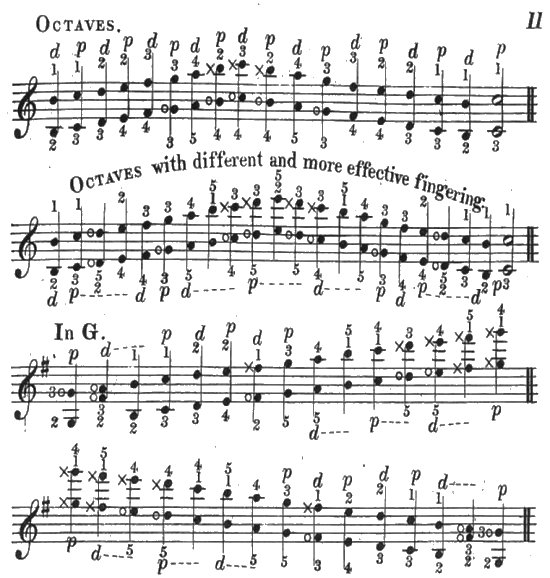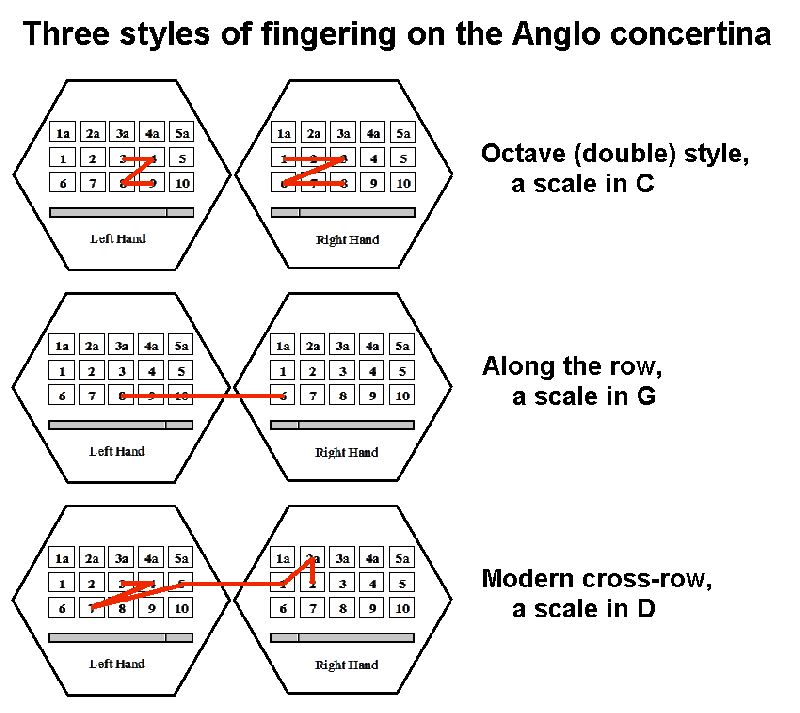

Musical notation from the Minasi tutor of 1846 that illustrates octave scales for playing in the keys of C and G.
This method became the most popular way of playing the instrument for house dances.
From The Concertina Library, www.concertina.com.
Musicians would play the concertina in a double-handed way, playing the melody separately on each hand, the right hand playing it an octave above the left. The fingers of each hand form a 'Z' pattern as they play a scale in octaves (see top part of illustration below). A more common approach, especially with beginning players, is to play the melody singly (one note at a time) rather than doubly, thus keeping the melody confined to a single row of keys (middle part of illustration). This is the so-called 'along-the-row' style of many later Irish players, especially those who played during the céilí dance era that followed the end of the house dance there. Boer and Irish players have refined the latter style into a cross-row approach that searches for the most efficient way to play any particular phrase, especially important with the more rapid tempos and/or increased use of ornamentation and chording in their respective modern musical settings (see bottom part of illustration, which shows one possible approach to playing a scale in D on an Anglo pitched in C and G).

The following sound illustration, an air recorded in the 1950s from the playing of legendary Clare player Stack Ryan, demonstrates the earlier octave style. Here he plays the air Eamonn a' Chnoic, which was recorded by Ciarán Mac Mathúna in the 1950s, who is the announcer in the track. The track is courtesy RTÉ, Ireland's Public Service Broadcaster.
The first part of the tune is played both singly and in octaves, with the octaves adding extra strength to the parts that Ryan chooses to emphasize. The second part is played mostly in octaves.
Another characteristic of playing for house dances consisted of the great simplicity of the techniques employed. Where many modern concertina players in Ireland might add generous helpings of ornaments to such a tune, and where modern English or Boer players might be tempted to apply a thick layer of interesting chords, Stack Ryan in the above recording is monumental in his simplicity of approach; there is nary an ornament in the entire piece. This relative simplicity is to be found in the playing of nearly all concertina players of this time, and was brought about by the needs of dancers for a strong, easily heard beat. Consider the following four dance pieces, one from each of the four countries.
In the first, Albert 'Dooley' Chapman (1892-1982) of Coborrah, New South Wales Australia, plays the Starry Night Waltz on an Stanley Anglo concertina. Track recorded by Bob Campbell in 1974. (Please note: biographical details of all the concertina players featured here are given in Part 2).
Scan Tester (1887-1972) of Horsted Keynes, Sussex England, plays St Patrick's Day Jig on a Jeffries Anglo concertina; recorded in the 1960s. Courtesy Vic Smith:
Martin Howley (1902-1981), Fanore, County Clare Ireland, plays Maggie in the Wood, a polka, on a German concertina. Recording courtesy of Jim Carroll and Pat Mackenzie:
Hans Bodenstein (1897-1978) and Die Vyf Vastrappers play an Untitled Polka. Bodenstein lived in Benoni, near Johannesburg South Africa. From a recording of the 1930s, courtesy of Die Tradisionele Boeremusiekklub van S.A.
The musicians who played the above four audio examples came from very varied locations and backgrounds, but they had one key thing in common: their general musical approach to a shared musical environment. They played simply and rhythmically, using melody notes that are often (although not always) doubled in octaves. During the ballroom dance era and concertina's heyday, the concertina player was often the only musician present in rural house dances that lasted from dusk until dawn. The dancers needed volume, a steady tempo, and a bit of lift, and because they paid the musicians, dancers tended to get what they asked for. Instead of emphasizing ornaments and fancy strokes, concertina players focused like a laser on a melody played simply and in octaves (for volume) and a steady, moderate tempo. Those who didn't were in for criticism from dancers. In this clip, Dooley Chapman comments on the lesser skills of many concertina players in his youth, including his brother Fred, who played along-the-row. Chapman was interviewed c.1981, and the recording is courtesy of Chris Sullivan.
In County Clare, Ireland, the late Tommy McCarthy (1939-2002) had a similar take on the needs of the dancers in country houses:
Octave playing developed partly because of the noise levels at house dances, partly because of the dancer's demand for steady rhythm, and partly because that style resoundingly fitted the jaunty, relaxed pace of ballroom dances. Sean O'Dwyer, of Dublin, whose mother Ella Mae O'Dwyer played for dances and in octaves (recordings of her are included below), put it this way:
The octave style also had an advantage for longevity of play. In dances that often employed a solo concertina player from dusk to dawn, the double notes allowed the melody to sing through even if one tired finger of a fatigued player missed a note; its twin on the other side of the instrument would likely still find the right button.
Not all tunes were played entirely in octaves. In Ireland, double reels were typically played singly throughout the tune because of their rapid tempo, even by musicians who were otherwise octave players (note: Irish-style double reels are much less common, to completely absent, in the dance music of the other three study countries). In addition, melodies were typically played singly in difficult or ornamented passages. Finally, some musicians would play the notes of the lower octave (left hand) only on the first and third beat in common time, which tended to emphasize the rhythm even more. Such players often would add a third interval note to the remaining lower octave notes, which created a partial chord an octave below the (right hand) melody that added yet more emphasis to the beat.
English musician William Kimber (1872-1961) of Headington Quarry, Oxfordshire made particular use of this technique in playing for social dances, such as Over the Hills to Glory, a schottische that he recorded in 1936. The track is courtesy of the English Folk Dance and Song Society.
Regardless of the use of such rhythmic techniques, and the addition of partial chords, the two hands still trace a 'double Z' pattern on the keyboard, and his playing is essentially a variant of the octave style. Kimber's particular playing technique will be dissected in a bit more detail in the tutorial of Chapter 12.
2. Sean O'Dwyer, 'The concertina in traditional Irish music', Free Reed, The Concertina Newsletter, No.14 (1973), pp.13-17.
| NEXT |